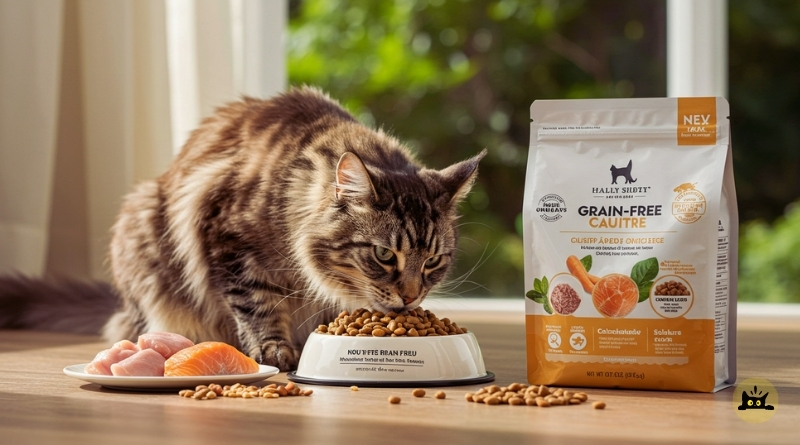Choosing the right diet for your cat is one of the most important decisions you can make as a pet owner. In the realm of Cat Food Nutrition, the debate between grain‑free and grain‑inclusive diets has grown increasingly significant with the rising popularity of specialized cat foods. In this guide, we explore the differences between these two options and offer practical insights to help you decide which one best meets your cat’s nutritional needs. Whether your cat has specific sensitivities or you are simply exploring new feeding options, understanding these choices can lead to a healthier, happier feline. From the very start, this Cat Food Nutrition guide emphasizes the importance of nutrient‑rich diets.
Cat Food Nutrition What is a Grain-Free Diet?
A grain‑free diet leaves out common grains such as wheat, corn, barley, and rice. Many manufacturers promote these foods as a more natural option, suggesting that they mimic what a cat might eat in the wild. Since cats are strict meat‑eaters and primarily need animal protein, many believe that removing grains can help lower the chance of allergies in sensitive felines. However, it is important to remember that not all cats are troubled by grains, and a grain‑free label does not automatically mean the food is superior. In some cases, replacing grains with other carbohydrates may also change the balance of nutrients in the food.
What is a Grain-Inclusive Diet?
A grain‑inclusive diet contains grains as part of the ingredients. Grains provide a valuable source of carbohydrates, fiber, and essential nutrients that support energy and digestive health. For many cats—especially those without grain sensitivities—a grain‑inclusive diet can offer a balanced mix of vitamins and minerals when paired with high‑quality animal proteins. Many experts find grains to be an affordable way to bring variety and ensure that the food provides all the necessary nutrients. With proper formulation, a grain‑inclusive cat food can contribute well to overall health without significantly increasing the risk of allergies.
Health Considerations for Cats
Cats have unique dietary needs that go beyond simply choosing between grain‑free and grain‑inclusive foods. Their bodies are built to thrive on high levels of animal protein, so the quality of meat used is crucial in any diet. While the grain‑free option may seem closer to what a wild cat would naturally eat, it is still vital that all other nutrients are kept in a balanced mix. On the other hand, grain‑inclusive foods can offer extra fiber and essential vitamins while focusing on superior protein sources. Veterinarians stress that there is no one‑size‑fits‑all solution; the best diet depends on your cat’s health, activity level, and any risk of allergies.
Practical Tips for Cat Owners
When deciding whether to choose a grain‑free or grain‑inclusive diet, start by reading the food labels carefully. Look for clear ingredients that provide high‑quality protein—such as real meat or fish—and ensure that any carbohydrates, whether from grains or alternatives, are easily recognizable and nutritious. If you suspect your cat may have food allergies or sensitivities, a grain‑free option might be worth a try; however, you should always consult your veterinarian first. Transitioning to a new food should be done gradually by mixing the new with the current food over several days to prevent stomach issues. Monitor your cat’s behavior, coat condition, and overall health during this change, as even small differences can be very informative.
Making an Informed Decision
Choosing the right cat food is not just about following trends; it’s about understanding your pet’s unique needs. If your cat has never experienced food allergies, a grain‑inclusive diet may offer a balanced approach by combining the benefits of grains with high‑quality proteins. However, if you have noticed signs of digestive discomfort or skin irritations that might be linked to grain consumption, trying a grain‑free diet under veterinary guidance might be more beneficial. Comparing different formulas side by side—looking at the ingredient list, nutrient balance, and even the cost—can further help in deciding. Remember, what works best for one cat might not work for another, so careful observation and professional advice are key.
Expert Opinions and Current Trends
Recent discussions in feline nutrition have generated interest in both grain‑free and grain‑inclusive diets. Some studies suggest that inconsistently formulated grain‑free diets might present risks, whereas other research shows minimal differences in health outcomes between the two diet types. Trusted veterinary organizations emphasize that feeding practices should be customized for each cat instead of merely following marketing trends. By choosing products supported by solid nutritional research and veterinarian recommendations, you ensure your cat receives a diet that not only meets its basic needs but also promotes long‑term health.
Conclusion
Both grain‑free and grain‑inclusive diets have their advantages and limitations, and the decision should ultimately be based on your cat’s unique health profile and nutritional requirements. While grain‑free foods might be ideal for cats with specific sensitivities, grain‑inclusive options can also provide a well‑balanced nutritional profile when properly formulated. By carefully examining ingredient lists, consulting with a veterinarian, and monitoring your cat’s overall well‑being, you can choose the diet that best supports your feline friend’s health. An informed decision today paves the way for many years of vitality and contentment for your beloved pet.
Sources : ASPCA, VCA Animal Hospitals, Merck Veterinary Manual

